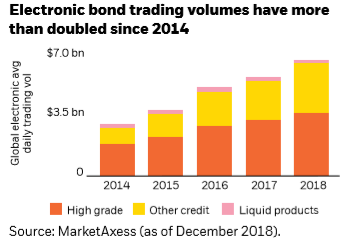Since the launch of bond ETFs back in 2002, investors have been able to gain exposure to fixed income without the hassle of relying on brokers who would spend hours working with Wall Street dealers. Despite many investors still preferring an active approach to fixed income, bond ETFs now have an annual growth rate of 22% with over 1,300 products available around the globe.
Earlier this month, the global bond ETF assets breached the $1tn barrier, however, this only accounts for less than 1% of the $105trn global fixed income marketplace. With such a large volume of capital invested in the asset class, BlackRock is confident bond ETFs have a lot of potential for growth and forecast the product' assets to double to $2trn by 2024.
BlackRock expects four trends to be the drivers for this growth. These factors being the evolution in portfolio construction, growing adoption by institutional investors, modernisation of the bond market and constant ETF innovation.
An evolution in portfolio construction
The key selling points of an ETF are its low-fees and liquidity. BlackRock says early adopters of bond ETFs used them to buy-and-hold positions that replaced individual bonds and higher-cost mutual funds.
Times have changed regarding portfolio construction however. Previously, investors would have to pick either an active or a passive approach whereas portfolio managers today can use a high yield bond ETF alongside individual securities.
Growing adoption by institutional investors
Pension funds, asset managers and insurance companies have been adopting bond ETFs for quick access to the market. This adoption spiked during the financial crisis, back in 2008, when banks and broker-dealers pulled back from bond market-making, reducing liquidity.
Additionally, the implementation of MiFID II has been a key driver for the adoption of bond ETFs. Investors are interested in trading volumes and what it is exactly they are putting their money in to, and the improved transparency you get with bond ETFs offer exactly that.
Modernisation of the bond market
Major government bond markets have already adopted the use of electronic bond trading with noticeable growth in corporate, emerging market and municipal debt markets. The digitisation of bond trading improves the efficiency of what the standard broker-dealer can manage.

The bond ETF ecosystem has developed to the point where it can rapidly price and execute individual bonds as a result of ETF market makers and authorised participants mastering the management of bond inventories.
Constant ETF innovation
Innovative ETFs are constantly rolling out to market as issuers respond to market demand. This includes sustainable investing as there has been a significantly large volume of Environment, Social and Governance (ESG) products launched in the last two years.
BlackRock expects more investors to adopt bond ETFs to minimise their interest rate and currency risk exposure. Currency-hedged bond ETFs have been one of these recent innovations enabling investors to disregard the FOREX risk when owning international bonds.
A recent interview with Brett Pybus, head of iShares EMEA investment and product strategy at BlackRock, revealed expanding share classes available, such as currency hedged versions of existing products, has been a priority of for the firm recently.
Additionally, albeit in its early stages still, factor-based bond ETFs are coming to market which offer investors to select bonds according to financial traits such as quality and value.



